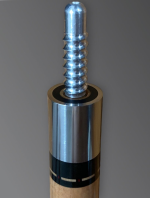I have several custom cues and have noticed that the cues with stainless steel joints have a small pin (5/16 x 14 or 5/16 x 18 thread), and that cues with synthetic or natural-material joints tend to have big pins (3/8 x 10 or radial). This also seems to be the case for custom cues I see that are for sale. This suggests to me that cuemakers use heavier pins with joints made of lighter material and vice versa.
However, one of my cues—the one I have been playing with—has a radial pin and a stainless-steel joint. It feels a lot different than my other cues, and I am beginning to wonder if the stainless-steel joint/radial pin combination may put too much weight in the center of the cue and throw off the balance.
My questions are:
However, one of my cues—the one I have been playing with—has a radial pin and a stainless-steel joint. It feels a lot different than my other cues, and I am beginning to wonder if the stainless-steel joint/radial pin combination may put too much weight in the center of the cue and throw off the balance.
My questions are:
- Do cuemakers tend to use smaller pins with stainless-steel joints (and am I correct in my reasoning)?
- How common is it to use a radial pin with a stainless-steel joint?
- Could this combination adversely affect the way the cue plays?
- If yes, is it possible (and would it make sense) to change the joint to a lighter-weight material?
